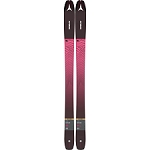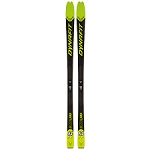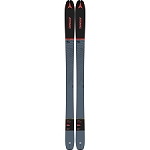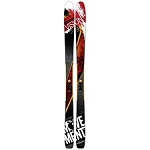Here we explain all you need to know about the different types of touring skis and how to choose the most suitable ones for you.

Touring skis
Skis for ski touring, skimo, alpine touring or backcountry are different to those used for other ski disciplines, but the huge range of models available often makes it difficult to choose.
Different ski tourers prioritise different styles. Some prioritise fast ascents, others prefer a freeride ski for descent; and between these extremes, there is room for a multitude of styles.
General Questions: Gear Compatibility, Ski Level, Size and Weight, Male-Female-Junior
Before explaining the types of boards available (ultralight, multi-purpose and freeride), let's discuss the above factors: equipment compatibilities and incompatibilities, ski level, size, board weight and its relation to performance, and boards for men, women and juniors.
1. Compatibility
When choosing your skis, remember that they form part of a set that consists of the skis, bindings and boots. As we will explain later, everything must be in sync. For this reason, we recommend you read our articles on How to choose ski touring bindings and How to choose ski touring boots..
There should be a certain harmony between the elements in this set. A rigid ski with a 120mm waist would be impossible to handle with ultralight bindings and competition ski boots.
Neither should a heavy freeride binding or boots be combined with ultra-light skis, designed for competition.
There are many incompatibilities between ski touring boots and bindings. That's why we have published another article explaining the details. We highly recommend reading it before purchasing.
Compatibility between ski touring boots and bindings
Unlike alpine skiing, where bindings are almost always integrated to the ski, it wasn’t until recently that brands started offering ski touring sets, consisting of the skis, bindings and skins. This is now gradually becoming more common.
These packs are an excellent choice as the items are carefully chosen by brands to avoid any incompatibility related issues.

Atomic Backland 80 PT + BL Tour + Skin pack
2. Ski Level
Being aware of your level when choosing a new pair of skis is a good starting point.
Bear in mind that for ski mountaineering, it is more important to be competent at skiing on all kinds of snow and gradients than having a good technical level in alpine skiing. This is a prerequisite for skimo.
So assess your level: your off-piste skills may not be the same as on-piste: the ability of some skiers may not go far beyond the fundamental turn, yet they are able to hold their own in the mountains, while other skiers may have a good parallel turn on-piste, yet have little or no confidence when it comes to tackling untreated snow.

Starting a 180º uphill kick turn. Mastering the technique is essential on steep slopes with hard sno
It is not only about having a decent level in downhill skiing and on all types of snow and slopes that matters: ascending difficult slopes on touring skis is a skill that must also be mastered.
- If you are a novice at skinning and kick turns or if you are not in great shape, choose skis that won't hinder your capabilities too much on the uphill.
- If you don't feel confident going downhill when the snow gets heavy, opt for skis with a wide waist and large rocker.
- Stiff, narrow skis will be of little use if your skimo technique is unable to get you to the bottom of your dream couloir, for example.
- If you have little knowledge of nivology, barely know how to use the avalanche receiver and are unclear about the avalanche protocol, you may need to limit your search for powder to the ski resort while you refine your skills.
- Match the level of commitment required to your skills and knowledge.

All-round skis: good for climbing, good for descents
3. Size
First of all, think about the type of ski touring you plan to do most, and choose the type of ski that best suits your expectations according to the factors already mentioned.
From there, it is easy to find your size using the brand’s size chart, finding the four or five sizes it is usually made in and following the indications for your size, recommended by the manufacturer.
4. Weight and its Relation to Performance
For increased downhill performance, and greater floatability, the ski should have a larger surface area, which means longer and wider, and a more reinforced core to make it stiffer. This inevitably means an increase in weight.
On the other hand, for increased uphill performance, it needs to be as light as possible: the lighter the ski, the less energy you use, both skinning uphill or carrying the skis on your pack. And this usually implies a loss of downhill performance.
There is no miracle solution to this clash of interests. But in the search for the ideal touring ski, R&D has put two main strategies into use. We will often see both in the same ski:
- Ultralight wood cores and carbon fibre have made a leap from the racing range to the all-rounder and freeride ranges in recent seasons. Because of this, whatever the size or stiffness of the ski you are looking for, you will probably be able to find a model in the top end of the range that drastically reduces weight without losing downhill performance.
- Reduced ski dimensions (below the standard "eighty-something" waist). Smaller skis/lighter skis. This has several benefits. Shorter and narrower not only means lighter, it also means less skin surface and therefore less friction in each step, better handling, and better edging, resulting in improved uphill performance.
5. Men, Women, Junior
Until not so long ago, touring skis were only for men. Now, like with alpine skis, there are women-specific models. And the growth of ski touring has even led to the emergence of junior skis.
The difference between men's and women's skis is related to the weight, stiffness, position of the bindings, and width. Some models feature all of these differences, while others feature only a few. The reasons for these differences are explained in our article on “All the Technical Mountain Gear for Women: Differences and Benefits”.
Some women prefer men's boards, and some men prefer women's boards. This is not common, but it can happen. In the article we explain why.

K2 Talkback 88, women’s touring skis
Types of Touring Skis: Which is Right for You?
When it comes to choosing the most suitable ski for your needs, you first need to make a realistic self-examination to understand your type of ski mountaineering. It is important to choose the skis that best suit your activity; (aggressive freerider or more serene ascender, extreme or more gentle descents, etc.).
Ski types categories range from ultralight race skis to freeride monsters.
- 1. Lightweight/competition
- 2. All-round
- 3. Freeride
1. Lightweight / Competition
Reducing the size of the ski is the most effective way to reduce its weight. And many of the models in this category follow this reasoning to the limits of legality, offering just a couple of centimetres above the minimum requirements for competition - 160cm for men and 150cm for women.
Several models in this category feature a similar construction to race skis, but with slightly more generous dimensions and these are confirmed favourites for skiers who enjoy long days of ski mountaineering or who want a ski that performs well for the occasional race but also handles well on on other days.
A very important factor to consider is durability..
Some ultralight skis tend to wear out faster. If you are familiar with this kind of gear, this will not be new to you and, you may consider that this is the price to pay for a faster ascent; but it is worth mentioning for newcomers.
The thickness of the core, composites, metal and plastic parts are often reduced to a minimum in this type of ski and this, of course, has a negative influence on durability.
These skis are for you if:
- Competition is your thing.
- The vertical climb is your main goal, even if you don't compete, or do so only sporadically.
- You are looking for approach skis that won't get in the way when carried on your pack, while climbing.
These skis may not be for you if:
- You are very corpulent.
- You are looking for a long-lasting ski that won’t leave you stranded.
- You like long or wide skis and you prioritise downhill skiing.
- Your touring style requires a versatile ski that balances the ascent and descent.

Dynafit Mezzalama, ultra-light skis
2. All-round Skis
Firstly, this is the category that suits up to 90 percent of skiers. If you're in doubt about which skis you need, it is highly likely that this is the type of ski for you. Those who choose a freeride or ultralight board usually have a very clear idea of what they need.
This group includes all kinds of solutions, from skis that perform well both up and downhill to skis closer to freeride models or ultralight skis. But the waist widths continue to grow year after year. Gradually, we are seeing more skis with over 90mm waist that barely exceed 1.2kg for lightweight boots and tech bindings.
This category ranges from very light skis that make the latest race ski technology available to the sportier all-mountain skier, to all-mountain skis for those who want to do everything with just one type of ski.
In other words, this category features all but the most extreme skis.
- Some lightweight models are close to the designs of the previous category and are designed more for approaching a mountain climb. These skis perform well on steep gradients, hard and deep snow, have a reduced sidecuts and are very light, so that they do not get in the way when strapped to your pack on the climb.
- Others are closer to pure freeride designs.
- But most designs are in the middle ground, and these are perfect for the average skier who does not plan to compete, or do mountain climbing and is not a freeride expert on the descent. In other words: the majority of ski tourers.
- Also in this category are skis more similar to an all-mountain alpine ski than to an all-mountain touring ski. These are aimed at those who want to ski on piste, enjoy a bit of freeriding and do some ski touring, once the season has ended.
These are all different approaches and strategies used in the search for the ultimate all-terrain ski.
These skis are for you if:

Atomic Backland 85 W, women’s versatile, all-round skis
3. Freeride / Freetouring Skis
As in the all-round category, many of the skis in this category have a marked all-mountain character that will be the constant companion to those skiers who want to do absolutely everything with just one pair of skis.
By selecting the right boot and binding you can make a powerful machine that not only performs reasonably well on and off piste, but allows you to enjoy your favourite slopes beyond the ski lift season.
We do not want to focus on pure and hard freeride skis. What we want to talk about is the growing trend over the past few seasons: skis with freeride sidecuts and lengths that optimize their construction and weight to limits that were unthinkable not so long ago, to achieve a ski that blurs the boundaries between the most aggressive freeride and classic touring designs.
Lightweight with exceptional handling means there is no need for a bulky boot or heavy bindings to control them. And this opens up endless possibilities for freeride enthusiasts.
Of course, most of these skis are more suited for skins than for chairlifts or helicopters. Some brands tell us "Powder for those who work it!". It is a new subcategory that some have called Freetouring.
And yes, many of the skis in our Freeride section fall into this new subcategory that is getting so much attention.

Movement Vision, touring skis for freeride
These skis are for you if:
- The only reason you would be seen skinning in the cold, at dawn, is to ensure you get the first descent on a slope with fresh snow.
- You are a skimo fanatic and want to complete your quiver. These skis are certainly for unforgettable days.
- You are looking for skis to combine your freeride adventures at the resort with the occasional trip to the mountains.
- After a heavy snowfall, too many riders are churning up the fresh snow at your favourite resort. Don't hesitate, open up new horizons.
These skis may not be for you if:
- Lightweight is essential.
- Hard snow is more common than powder in your area.
- You are new to skinning. The width will make it harder to skin uphill on hard snow and its length will make certain manoeuvres, such as kick turns, more difficult.
On-line store: www.barrabes.com

















Leave a comment
Be the first to comment on this article.